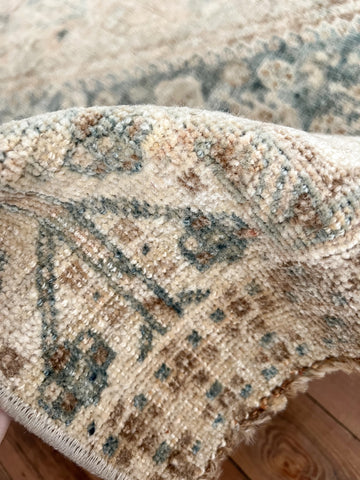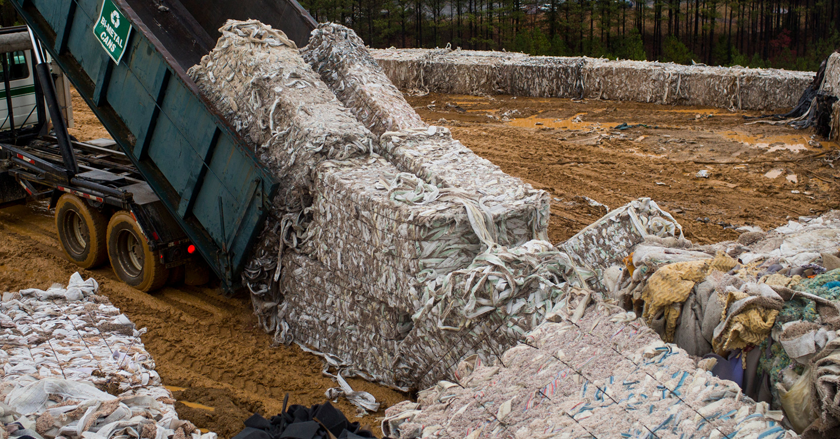As the call for more sustainable products strengthens, so does the need to reevaluate the current state of the carpet industry. The carpet industry has recently come under scrutiny for its lack of sustainable actions, and for good reason. Much of the carpet industry is wasteful, and there is massive opportunity to implement changes that support a circular economy. This article discusses sustainability in the carpet industry, provides an overview on which materials are more sustainable than others, gives a quick overview on greenwashing in the industry, and provides ways you can support a more sustainable carpet industry.

In 2014, the U.S. carpet industry produced 11.7 billion square feet of carpet and rugs, and around 3.5% of all waste in U.S. landfills is discarded carpet. The vast majority of carpet is still thrown away, and of the 5% of carpet that is recycled, only 20% is recycled back into carpet. The future of sustainability in the carpet industry is to design carpets that are fully recyclable for a circular economy. A circular economy is defined as an economy that focuses on developing a “closed-loop” system where resources are not wasted, and focuses on advancements in product design, materials, manufacturing, and recycling to lead to a zero-waste outcome. Currently, it is difficult for consumers to gather a holistic understanding of the sustainability behind the carpet and rugs they are purchasing. Having demand from consumers to own more sustainable carpet is an important first step in creating lasting, impactful change in the carpet industry, with the goal of supporting a circular economy. Below is a high-level overview of what materials to look for when analyzing the sustainability of rugs and carpet.
Most Sustainable Carpet Materials
Not all carpet and rug materials are created equal, and some materials are much healthier for you and the environment than others. First and foremost, the most sustainable option is to choose a rug that is not only made from recyclable materials but can also be recycled again at end of life to be used in another rug or carpet. One of the most sustainable rug and carpet materials on the market you can choose is wool. Wool is entirely natural, void of any harmful chemicals, extremely durable, stain-resistant, biodegradable, and can be recycled or upcycled into future new rugs or carpet. Additionally, wool materials purify indoor air by absorbing volatile organic compounds (VOCs) and retaining the VOCs within the wool. Wool can also purify indoor air for up to 30 years! Other stand-out, sustainable materials for carpets and rugs include jute (a species of tall grass), sisal (made from agave plants), seagrass, and organic cotton. While recycled PET carpeting made from recycled milk jugs or soda bottles is becoming a fast favorite in the carpet industry, there are two downsides to this material. The first (and main downside) is that it is difficult and not economically sensible to recycle PET carpeting at its end of life. So many of these carpets are still sent to landfills. The other downside to PET carpeting is that tiny plastic microfibers may shed off the carpet and be indoor pollutants, but regular vacuuming should control the shedding.

Image: 100% wool on wool Shiraz
Least Sustainable Carpet Materials
On the flip side of this, some of the most popular materials found in carpeting today are some of the worst for the environment. Some of the most commonly used yet least sustainable carpeting materials are nylon, polypropylene, and polyester. These materials are synthetic fibers made from petroleum. Significant amounts of greenhouse gases are released when creating these materials, and the carpet fibers emit harmful VOCs into the air. The business appeal of these materials is that they are fairly durable, and easier and cheaper to produce. The downside is these materials are made of plastics and are usually treated with harmful chemicals and dyes. While they can sometimes be recycled, most times it is not economically feasible to recycle these materials.
This results in mass production, a relatively short life span at 3-5 years, and then disposal in landfills. Without being recycled, nylon, polypropylene, and polyester rugs will build up in landfills and take a very long time to break down - we’re talking hundreds of years. They are the main contributors to the four billion pounds of carpet discarded in landfills every year.
Carpet and rug waste ending up in landfills has steadily increased since the 1990s and will continue to increase unless significant changes occur. While it may seem appealing to buy inexpensive, heavily discounted rugs, these rugs are usually of poor quality, and typically reach their end of life much faster than carpet with quality materials, which can last over 100 years.
Purchasing poor quality carpeting ends up being more expensive than buying a carpet with quality materials, as you end up needing to continually replace the poor-quality carpet. This is an additional strain on your wallet and leads to excess material waste hitting landfills. If possible, aim to invest in a quality carpet or rug to save a little cash down the road and protect the planet from additional waste.

Image: Polypropolene, nylon, polyester vintage-inspired rugs
Greenwashing
As the demand for more sustainable products increases, so do the sustainability pledges, promises, and statements from major carpet companies. While some companies are indeed making changes and integrating sustainability into their products, many are making sweeping environmental goals and claims with little evidence of any improvements. The main reason greenwashing still exists is because of a serious lack of transparency in the industry. There is no regulatory framework or government body holding any of these carpet companies accountable for their claims. It is near impossible to track or measure the validity of the claims, like the number of products made from recycled materials and how much of the product is being recycled. This makes it even more difficult for consumers to understand what they are purchasing and enables major carpet companies to make false claims without receiving any penalty for their actions.

The Good News
While the U.S. carpet industry is not a leader in producing sustainable product or recycling, improvements have been made and the demand for more sustainable, healthy products continues to increase. More and more consumers are looking for quality, eco-friendly products and are willing to pay a premium (at least to some extent) for these products.
How You Can Make A Difference
As the world grows more aware of the urgency of combatting climate change, there is increased pressure for transparency and accountability. Companies are no longer getting away with lofty claims and are under ever-increasing scrutiny to make eco-friendly improvements. Carpet retailers have a huge opportunity to play a role in enforcing accountability by promoting the sales of sustainable carpet and demanding clear, accurate information from carpet companies. But how can you as a consumer help drive change in the carpet industry?

Image: Jute rug made from organic materials
Seeking out sustainable carpet or rugs made from wool, jute, sisal, seagrass, or organic cotton is a great way to support eco-friendly practices in the industry. Purchasing products made from these materials increases demand and shows carpet companies that consumers are interested in these products. Another great way to support sustainability in the carpet industry is to purchase carpets and rugs with a green certification. Credible certifications include Cradle to Cradle Certification, the Carpet and Rug Institute’s Green Label, Greenguard, Global Organic Textile and Latex Standards, and Green America. Additionally, encouraging friends and family to purchase sustainable carpet and rugs (or purchasing these as gifts) helps spread the word and increase demand as well. While change will mostly be driven by laws, regulations, and carpet retailer and competitor pressure, consumers can actively work to choose more sustainable products when purchasing carpets or rugs and further drive the demand for change.






